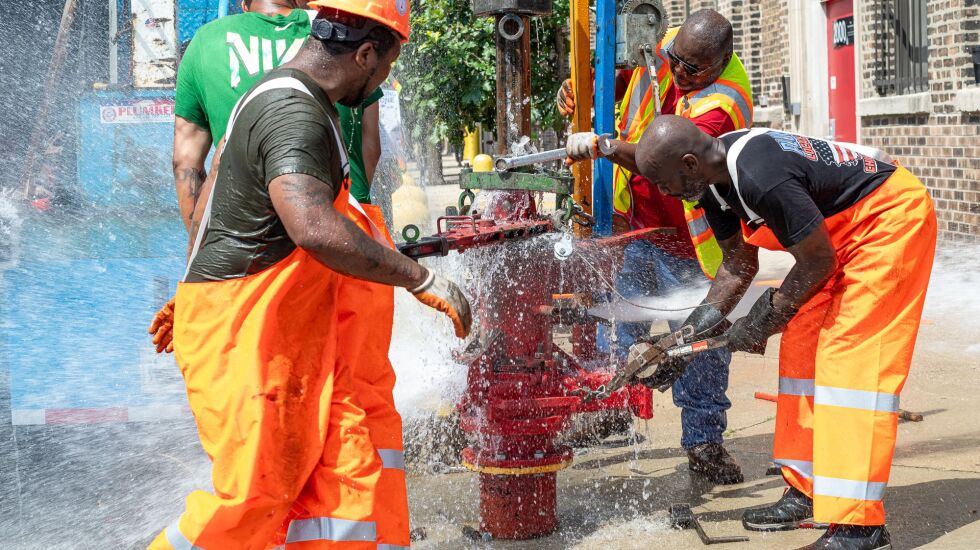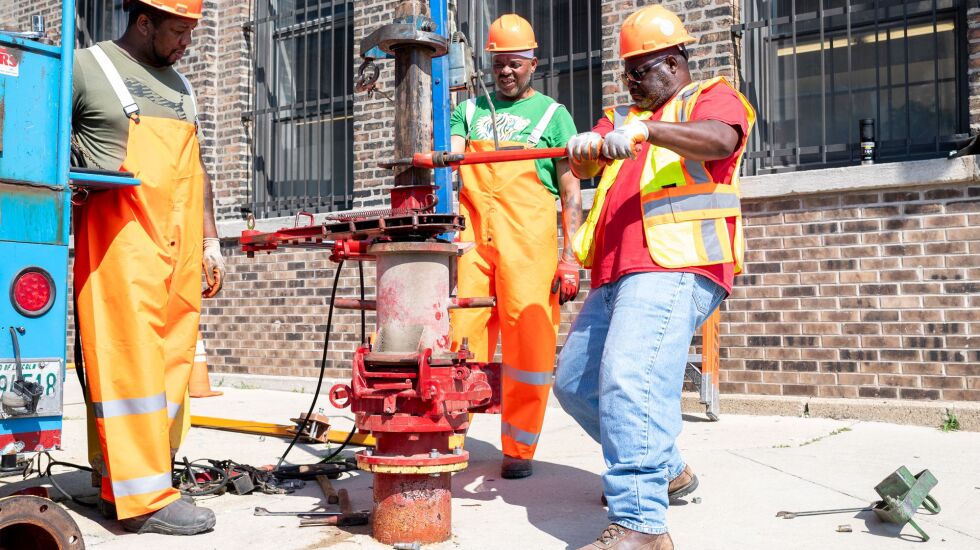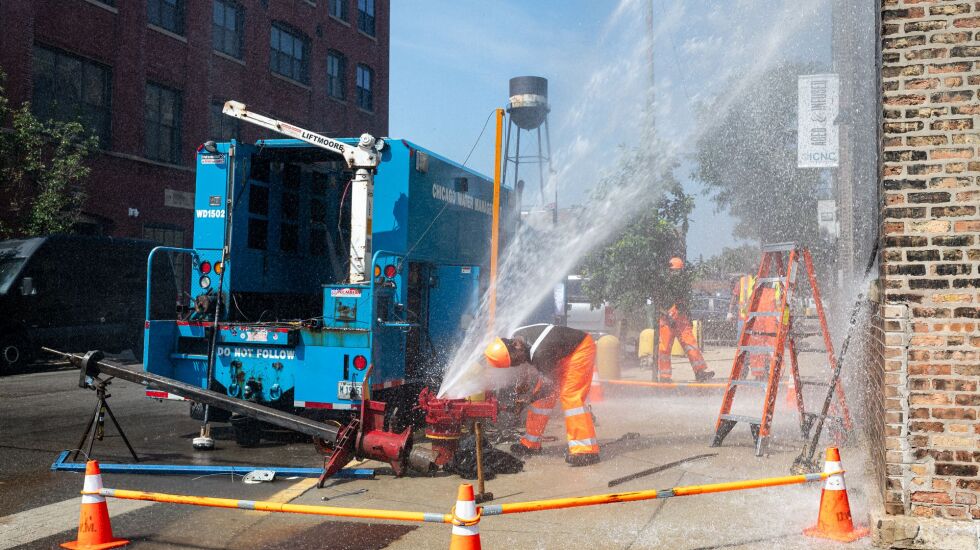
The fire hydrant on the northwest corner of Damen and Fulton is “jumpy.” Meaning, in Department of Water Management parlance, that water can be heard vibrating within the cylinder, a tip-off that the neoprene seal inside has decayed and is leaking.
A leaking fire hydrant wastes water, and in winter will freeze, rendering it useless — common enough that on really cold days the Chicago Fire Department routinely sends four engines to a really big fire, setting up north, south, east and west of the scene to make sure they tap enough working hydrants.
The public is generally unaware of the water department’s important role in firefighting — any fire 2-11 or above requires a hydrant truck be dispatched. Their steamers can thaw a hydrant in 10 minutes, and sometimes a main must be shut down so the CFD can remove their hoses, though that can cause another complication — the main must be turned back on. When the old McCormick Place burned down in January 1967, blame fell to the surrounding hydrants, most of which didn’t work. Not due to being frozen, as first believed, but because one valve that was supposed to be open was closed.
So a jumpy hydrant can’t be ignored — it can be the difference between life and death. A week ago Friday, one of the water department’s four hydrant repair trucks was dispatched to fix the hydrant at Fulton and Damen.
Not an easy task.
It would be a lot easier if they shut off the main — but that would also cut water for blocks around, including the Chicago Teachers’ Union headquarters across the street and an array of nearby hip brewpubs. For hours. Work would have to be done at night, which means overtime for a crew of four.
To yank out the seal of a fire hydrant while still under pressure and replace it with a new one requires a large, complicated tool the water department calls a “gun” — a 10 foot tall assemblage of pipe, part tent pole, part giant socket wrench, that easily weighs 200 pounds. It seals off the hydrant so it can be opened while under pressure. Only one company in the world makes them to fit Chicago’s unique style of hydrant, and occasionally a pickup truck arrives to collect a broken gun and take it back to Texas for repairs. Water workers call the process, with an occasional blush, “jerking.”
Dangerous work for them — and passersby
The device takes about an hour to set up by the truck crew — Kevin Franklin, Robert Laws, Dorian Minor and supervisor Charlie Brown, who between them they have well over a century on the job. Three wear bright orange rain pants — hydrants are 2 feet from the curb, and — talk about pressure — vehicles rushing past pose a constant peril to the workers. Pedestrians blithely blundering by put themselves in danger.
“We have to worry about their safety and ours,” Laws said.
Tragedies occur. At the end of June, a water department plumber, investigating a leak in the street by the Old Post Office, was hit by a Chevrolet Tahoe and seriously injured.
“This guy just ran her over,” said Daniel Misch, superintendent of construction and maintenance for the Department of Water Management. “He didn’t even know he hit her.”
The head of the hydrant is removed, the threads of the gun coated with cooking grease — an edible lubricant, since it could in theory backwash into the water main and come out of your kitchen tap, eventually.

The gun is winched from horizontal to vertical and bolted to the barrel. Or would be, in an ideal world, one where bolts line up the way they’re supposed to. In the real world, at the corner of Fulton and Damen one Friday at 10 a.m., the bolts are a quarter inch off.
“It’s definitely off center,” said Minor. “It never happens like that. I don’t know why.”
The crew tries various brute-force solutions using 2-pound drilling hammers and crow bars, to realign the bolts while trying to muscle the gun into place. Losing fingers is also a concern, one they view philosophically. “You’ve got nine others,” Misch quipped.
Chicago hydrants stand apart
While they work, we can review the hydrant situation in Chicago.
Some 48,000 Chicago Standard fire hydrants speckle the city — about three a block, at each end and in the middle, putting them about 300 feet apart. They are unique, twin-port outlets, wider than suburban hydrants.
“We’re the only ones with a four and a half inch port,” said Misch. “If you look at the suburban hydrants, they have a two or 2½-inch port. We run at low pressure, higher volume. Where a lot of suburbs run at high pressure.”
All are painted red — if you see a green hydrant, it’s privately owned.
Chicago hydrants are made at the East Jordan Foundry in Elmira, Michigan — all except for one, from Mueller, a sui generis experimental hydrant set up outside the water department yard at 3901 Ashland.

A fire hydrant is like an iceberg — most of it is out of sight. About 2 feet project from the street, then another 5 feet below the ground, reaching down to the water main. Some have color-coded bands revealing what size main they are attached to, hinting to firefighters how much water can be pulled out without sucking the main dry.
To open a hydrant, a firefighter turns the nut on top attached to a stem screw some 7 feet down, raising the seal and allowing water to come out. This has to be done just right.
“They teach them at the academy that hydrants are to be opened slowly and closed slowly so as not to cause any damage to the hydrant itself,” said CFD spokesperson Larry Langford.
That said, sometimes training is forgotten in the excitement of a fire.
“We call them ‘cowboy firemen,’” Misch said. “If they’re hyper to turn them on, they might snap a stem. If they crank that hydrant down too quick, it could pop the water main.”
Leave the hydrants alone
That’s why the city discourages Chicago civilians from opening fire hydrants, a traditional way to cool off on hot summer days. Valves get broken and streets are undermined by gushing water — which can also push children into traffic where they are sometimes killed (the spray obscures their presence, and drivers going through the mist hit them). City workers trying to keep hydrants closed are sometimes assaulted.
“It’s very dangerous for me to send men out to shut these off,” Misch said. “Everybody’s hostile, they don’t want you turning it off. What people don’t realize is when you turn them on, it takes pressure away from houses getting water.”
Chicago residents can legally draw water from the hydrants in some situations, if they go through application hoops. “Community Gardens, Urban Farms, Festival and Contractors” are permitted access, if they buy the necessary wrenches and fixtures and pay fees. Cost is $83.78 a day, plus the water.

Vandalism is a perennial problem with hydrants — broken open for the few dollars worth of brass. Thefts are down — Misch suspects a combination of their vigilant head of security, and catalytic converters offering a richer payday to thieves. In 1964, two children died in an arson on North Wood after the fire department pulled up and found the two nearby hydrants “dismantled and damaged.” Recycling centers are forbidden by law from accepting hydrant parts.
But as a rule, inoperative hydrants are rarely a problem.
“It’s not a bad issue,” Langford said. “The nice thing about Chicago’s hydrant system is, in most neighborhoods, hydrants are 300 feet apart, so if we have a failed one we’re not far from a good one.”
‘Use the ax’
Firefighters are known to gleefully hatchet through the windows of cars parked in front of hydrants if they need to run a hose to a fire. The practice was not only immortalized in the Chicago-based film “Backdraft,” but was originally official CFD policy.
“Use the ax,” Al Goodrich, the first fire commissioner, told his department heads on Oct. 4, 1927, when it was revealed that 300 hydrants in the Loop were routinely blocked by parked cars.
Do firefighters really do that?
“Not too much,” Misch said. “Maybe in the old days. But I haven’t heard of it lately.”
After a fire, the barrel of the hydrant can still be filled with water — there’s a 3/4-inch drain on the bottom, and if that drain clogs, the water remains. Between now and October, the city’s 98 firehouses go around their neighborhoods, flushing and draining the hydrants, hand-pumping them dry, a process firefighters call “guzzling.”
“They make sure the hydrants are operating,” Langford said.
Speaking of which. At Fulton and Damen, the gun is finally bolted to the barrel by tipping it and using the turning bolts to force it into place.
“It’s going!” Minor said. “A little bit more!”
The gun is a giant socket wrench, run off the hydraulics in the truck, that can reach down 5 feet under the street and unscrew the stem with its jumpy seal.
Hidden in hydrants
The operation does not go smoothly. Something is clogging the hydrant. Chicago hydrants are put to all sorts of non-aquatic purposes — people hide weapons and bags of drugs inside. Bees have taken up residence in Chicago hydrants.
“It’s amazing the things people throw in these things,” Misch said.

The hydrant has to be opened. Water geysers out, soaking all four workers. After much effort, the culprit is revealed — a large bolt of black plastic that has come up through the main and lodged in the hydrant.
“That’s a whole 20-footer right there,” Franklin says.
Speculation as to the source of that plastic identifies a culprit, but not for publication. Let’s just say the obvious: plastic intended to wrap around the pipes ended up inside them.
“This is why it was leaking,” Laws said.
With this development, the main has to be turned off anyway. The new stem and seal is finally installed. The job was supposed to take and hour or two. Thanks to the various problems encountered, it takes more than three.
The old stem is discarded, its black neoprene seal ragged, as if chewed by bears. Water will do that.







